Take Better Pictures
Text and photographs by Ken Frick
A veteran photographer offers simple tips for taking more dramatic and memorable photographs of his favorite subject —- Scouting.
I’ve aimed high. But just as often I’ve aimed low. In fact, Scouts of Troop 73 in Grandview Heights, Ohio, will tell you that I’ve aimed my camera at almost everything at every place we’ve ever visited.
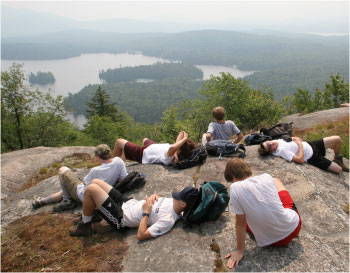 Photo opportunities are often onetime events, so always be ready to take advantage of them, like this break during a mountain hike. |
From our home in central Ohio, we’ve been east to the Adirondacks in New York State, and west, all the way to Baldy Mountain at Philmont Scout Ranch in New Mexico. And to dozens of places in between.
Taking pictures is what I do. From my 25 years as a professional photographer, I’ve learned to maximize my chances for capturing the best image possible, and you can as well.
The first thing you must do is make a commitment to take better pictures. You can do that right now.
Don’t make a production each time you reach for your camera. If your Scouts are familiar with you and know you are always taking pictures, the results will be more natural and candid photographs.
Be prepared, photographically
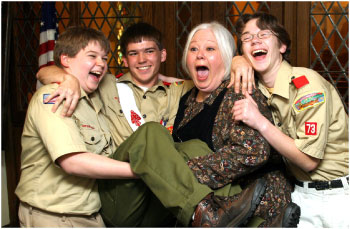 The best photographs often reveal emotions. |
The choice between shooting digital or film images is up to you. The art of taking great photographs, and not mere snapshots, depends more on experience and recognizing opportunities than on what type of camera you own. That said, some people never crack open their camera’s operating manual. And that is a mistake. The manual can often provide great tips for maximizing your camera’s features for better picture taking.
If you have a film camera, always carry an extra roll (or two) of film, and if you are using a digital model, always have sufficient memory card space available.
Be sure you have new, or fully charged, batteries before every outing. If you will be outdoors, protect your camera from the elements by keeping it in a sealable freezer bag. On our hike at Philmont, I slept with my camera’s batteries in my sleeping bag to protect their charge from draining in the cool temperatures.
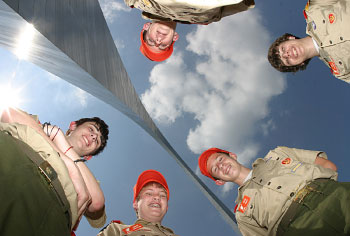 Look for different angles, like shooting up. The arch in the background adds an interesting element, while the camera's flash lights the boys' faces. |
Try a different angle
An ordinary picture can become a far more interesting photograph by shooting it from an offbeat perspective. Ask yourself if aiming your camera up from a lower angle would produce a more exciting image. Perhaps you should hold your camera over your head and shoot down.
In the photograph of our Scouts at the St. Louis Gateway Arch, I lay on the ground and aimed straight up. With hundreds of people within a few feet, my picture includes only our Scouts and the arch.
Most “point and shoot” cameras have a built-in zoom lens that will allow you to focus tightly on your subject or take in a wide area of view. Practice holding your camera steady when zoomed in because “camera shake,” or blurry images caused from camera motion during the exposure, are more obvious with a telephoto lens. Some of the newest digital cameras reduce this with an image-stabilizing feature.
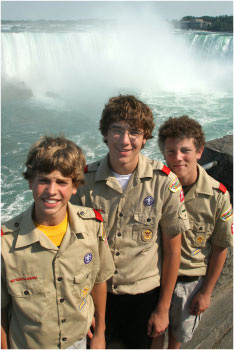 In this picture of a Scout portaging a canoe, "fill flash" was used to illuminate the boy's face while a slower shutter speed added a feeling of motion. |
Get close to your subject when the lens is set for wide-angle shooting. Note how large the boys are in the picture taken at Niagara Falls. Notice how much of the falls can be seen. Here, I held my camera over my head and aimed down to get the shot I was looking for. Be careful when taking pictures like this, however, because the autofocus feature on your camera may focus on the background rather than your subject.
Add some light
If it is dark where you are shooting outdoors or if your subject is in the shadows, consider using “fill flash,” which adds light to your subject. Set the camera’s flash to go off, even though the picture you are taking may be outdoors. In the photograph of the Scout portaging his canoe, fill flash illuminated the Scout’s face, and a slower shutter speed added a feeling of motion to the image.
You can also coach your subjects. A camera gives you license to direct people for a shot. And usually, in group pictures, your subjects will look to you for instruction. Always ask if everyone in the group can see the camera. If someone says he can’t, he is not in the picture.
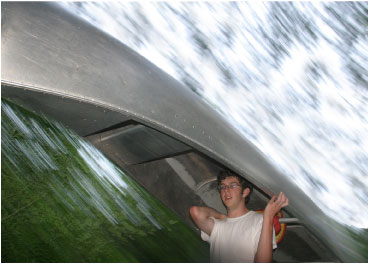 In this picture of a Scout portaging a canoe, "fill flash" was used to illuminate the boy's face while a slower shutter speed added a feeling of motion. |
Create permanent memories
The best photographs are often ones revealing emotion. Eagle Scout ceremonies are a great opportunity for this sort of image. Be ready. Happy people at fun events are prone to do fun things.
Many of Scouting’s photo opportunities are onetime events. Take the initiative. Step forward and ask permission to take a picture. Photographs are how we share our activities with those who weren’t present.
When your Scouts have grown into adulthood, and high adventure trips to Philmont or the Florida sea base are but a distant memory, your photographs will be all it takes for them to return to their childhood. And you, of course, will treasure the memories as well.
Ken Frick, committee chairman for Troop 73 (chartered to Boulevard Presbyterian Church), Grandview Heights, Ohio, has been a professional photographer for more than 25 years.
Saving for the Future, Planning for Now
After years without an album, our troop recently decided to begin a new one. It’s a great way to show off our program to the boys and parents we are recruiting. We combine photographs from our activities, along with travel pamphlets and brochures, and newspaper articles about the troop. All are inserted into acid-free, archival album pages. In addition to the items we collect, each boy is given space for four pictures from his Eagle service project. Additional space is reserved for more pictures and printed materials, such as his Eagle Scout court of honor invitation and program. The album is displayed at Scouting events throughout the year so our boys and their parents can keep up on what we’ve collected. We hope that in 50 years when the boys of Troop 73 look at our album they will have fond memories of their years in Scouting. —K.F. |
October 2007 Table of Contents
Copyright © 2007 by the Boy Scouts of America. All rights thereunder reserved; anything appearing in Scouting magazine or on its Web site may not be reprinted either wholly or in part without written permission. Because of freedom given authors, opinions may not reflect official concurrence.
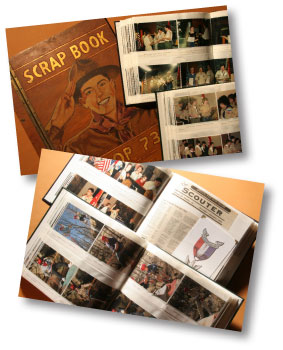 The first Troop 73 Scout photo album was started in the 1940’s. Its hinged, wooden cover and 30 bound pages are beautiful. While the album exhibits a marvelous historical record of our troop from a different era, it’s amazing to see how little Scouting has changed over the years.
The first Troop 73 Scout photo album was started in the 1940’s. Its hinged, wooden cover and 30 bound pages are beautiful. While the album exhibits a marvelous historical record of our troop from a different era, it’s amazing to see how little Scouting has changed over the years.